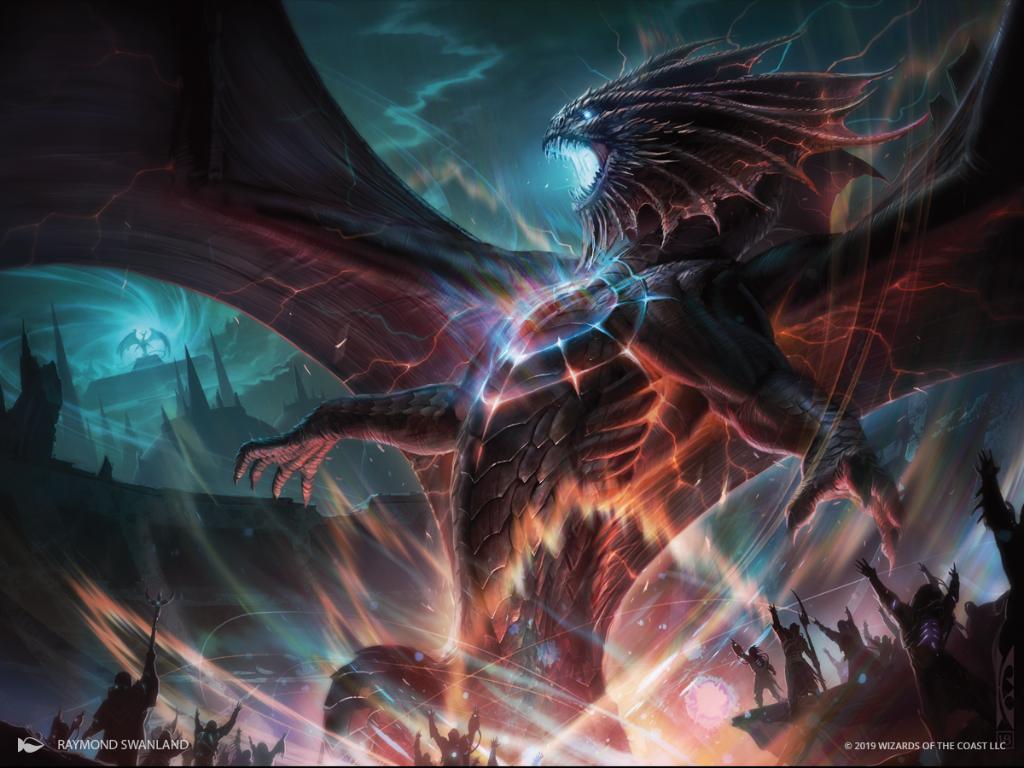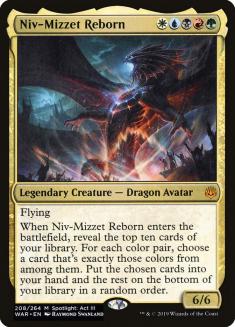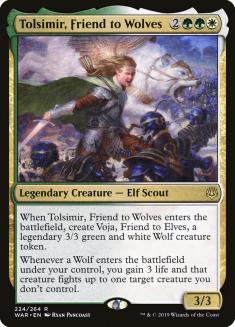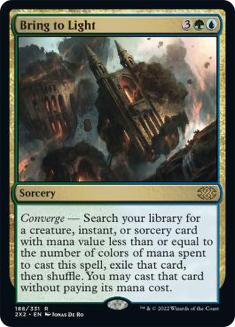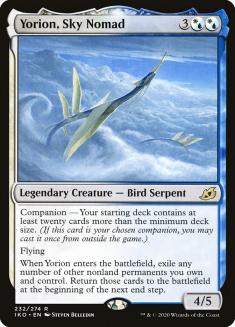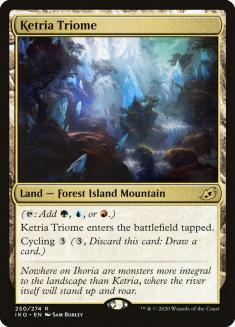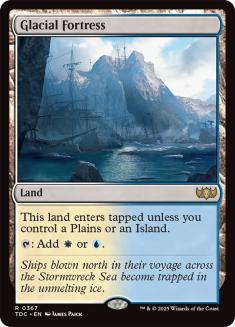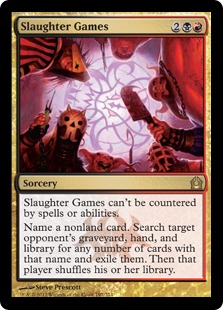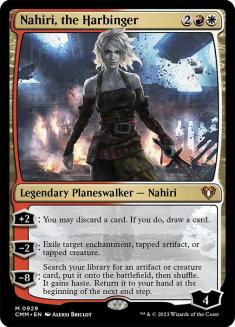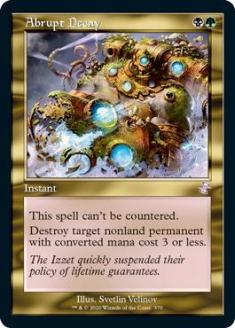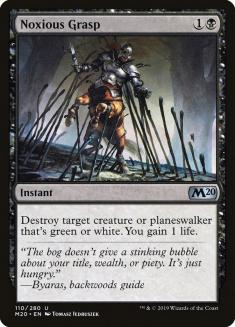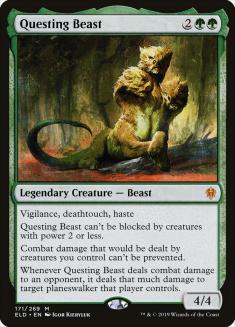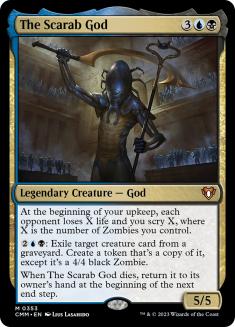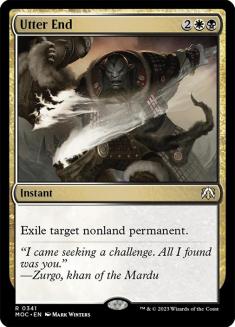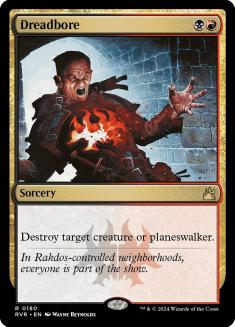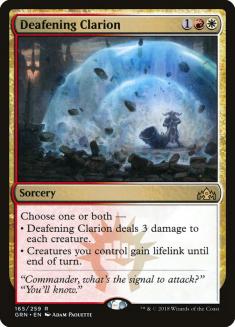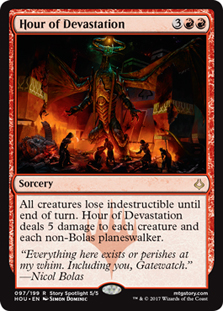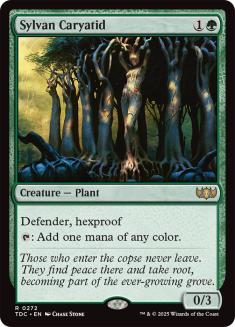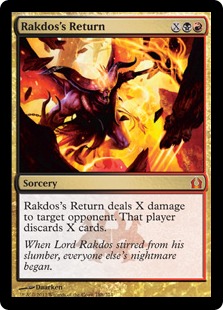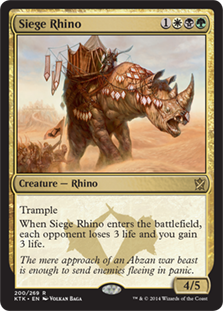After a hearty lunch in Renton, Wizards of the Coast (WotC) issued sweeping changes to Pioneer that reset the rules of engagement in the format. Since the release of Theros Beyond Death, Pioneer has been defined by a dedicated combo deck in Lotus Breach and a resilient combo-control deck in Dimir Inverter.
This double act stole the show at the first round of Players Tour events in February, which were meant to be Five-Color Niv-Mizzet’s Broadway debut. These decks shrugged off the bread-and-butter interaction that forms the backbone of midrange strategies like Sultai Delirium or Five-Color Niv-Mizzet, which in turn meant that anyone trying to compete with them had to win as quickly as possible. Trying to keep pace with this aggression made midrange even weaker to the combo decks that created this dynamic in the first place.
Paulo Vitor Damo da Rosa was able to Top 8 the Players Tour in Brussels with Five-Color Niv-Mizzet in this hostile environment — on zero practice, as he was preparing to become World Champion a few weeks later — but the rest of us who aren’t the best player of all time had to put Magic’s most stubborn Dragon back on the shelf for now.
With anything resembling ‘combo’ unceremoniously ejected from Pioneer, interest in the format and Niv-Mizzet’s prospects in it have been reborn. Five-Color Niv-Mizzet won Saturday’s Pioneer Challenge on Magic Online in the hands of Piper Powell and took Gabriel Nassif to the finals of Sunday’s Pioneer Showcase Qualifier. Pioneer League trophy leaders claudioh and JapaneseFisherman earned their spots atop the leaderboard with Five-Color Niv-Mizzet and show no signs of stopping soon.
Creatures (16)
Planeswalkers (6)
Lands (32)
Spells (26)

Creatures (16)
- 3 Deathrite Shaman
- 4 Sylvan Caryatid
- 1 Tolsimir, Friend to Wolves
- 4 Niv-Mizzet Reborn
- 4 Uro, Titan of Nature's Wrath
Planeswalkers (6)
Lands (32)
Spells (26)

Creatures (14)
Planeswalkers (6)
Lands (23)
Spells (17)

As an interactive midrange strategy with a colourful twist that encourages variety in deckbuilding, Five-Color Niv-Mizzet is the perfect embodiment of the murky mission statement that WotC has carved out for Pioneer. Its recent success is a good sign for the format and understanding that success is essential for anyone playing Pioneer right now.
In a conventional game of Magic, it’s hard to do better than Uro, Titan of Nature’s Wrath. Compared to Sultai Delirium, Five-Color Niv-Mizzet lacks the bevy of cheap black interaction to cast before or alongside Uro and the Satyr Wayfinders that dig for Uro while fueling a fast escape, but it makes much better use of the acceleration Uro offers by casting its flagship five-drops a turn sooner. This is important enough that previous lists played secondary ramp creatures like Paradise Druid or Gilded Goose that increased the risk of flooding in the mid-game. Uro fills this role much better while also removing the tension between using Bring to Light as a toolbox card and using it to find a threat.
Uro’s floor is always impressively high but it’s at its best in a format like this newest iteration of Pioneer, where games are won and lost on the battlefield and accumulating resources often translates to success. Niv-Mizzet Reborn flourishes under the same conditions, putting you ahead on card quantity and quality at once and reliably outsizing anything on the battlefield. In addition to finishing the game quickly by itself, it’s also likely to find whatever you need to stabilize the battlefield if you untap or shut off the opponent’s remaining outs. This reward is easily worth juggling all five colours in your manabase and choosing your spells with Niv-Mizzet in mind. However, many players have been led astray by a type of greed that Niv-Mizzet enables all too well…
A strong indication that Five-Color Niv-Mizzet is legitimate is that people are posting good results despite filling the deck with all manner of nonsense. A classic offender is Tolsimir, Friend to Wolves, a card that’s unreliable against the aggressive decks it’s supposed to be good against — one removal spell counters the fight and lifegain clauses and both bodies are too small to matter — and dismal against everything else.
Nobody would dream of playing it if it cost 3GG or 3WW, but its Selesnya guild membership tricks people into trying it in the hope of running up the score with Niv-Mizzet Reborn. You don’t need to run hard-to-cast, below-rate cards so that resolving a Niv-Mizzet has the possibility of drawing five cards instead of four — not least because most of those cards are better follow-ups anyway! This is especially true for cards that are intended to stabilize the game against aggressive decks; if you’re untapping with options after resolving Niv-Mizzet Reborn, your position is already fine.
This lack of discipline trickles down the curve. The fact that the mana theoretically supports all five colours doesn’t mean that you can throw colour requirements out the window — curving Abrupt Decay or Dreadbore into Teferi, Time Raveler will never be trivial. Having to sequence your lands suboptimally or pay extra life for a shockland to cast your spells is costly when games are won on tight margins — and, unlike the Modern Niv-Mizzet decks, you don’t have a land like Pillar of the Paruns that actively encourages multicolour cards.
Your end-game is so powerful — the biggest and best Mulldrifter of all time; a Bring to Light toolbox; and Uro, Titan of Nature’s Wrath — that getting there should be your priority. For example, if you want to prepare for Mono-Green Devotion after its resurgence last weekend, you should look at cheap, monocoloured spells like Noxious Grasp. If you have to send a copy away with Niv-Mizzet, I’ll break out an orchestra of tiny violins for you.
Bring to Light is the perfect complement to Niv-Mizzet Reborn, giving you four more copies of the deck’s namesake when it’s the best thing you can do and finding specific tools when the fair fight that Niv-Mizzet dominates is the wrong fight.
Balancing the desire to maximize Niv-Mizzet’s upside, the flexibility of Bring to Light, and pragmatism over the deck’s mana requirements and curve is tough even for a skilled deckbuilder. Your access to the whole colour pie adds to this challenge; you can find a Bring to Light target for any situation and it’s easy to pad the deck with situational cards that offer an illusion of security at the cost of consistency.
Bring to Light also makes individual card choices more important; using just one slot on a silver bullet for a matchup can drastically swing your equity there compared to the minimal effect that would have in most decks. You have more choices, they are more difficult, and getting them wrong matters more.
This takes on a new dimension when you make the deck larger…
Yorion, Sky Nomad has found many homes in Pioneer even with the new companion rule and Five-Color Niv-Mizzet recently joined that list. Although this version has become the norm, I believe this is further proof that the core is strong enough to shake off a lot of dead weight. Yorion has a dream target in Niv-Mizzet Reborn but few realistic targets aside from the newly unbanned Oath of Nissa, which is itself subpar in this shell, and Oath of Kaya, a fine card in small quantities but not enough to justify this level of commitment. Yorion has some tension with Uro, asking for permanents that remain on the battlefield instead of helping Uro escape its chains.
Moving to 80 cards makes it harder to support specific mana requirements (not least because you draw Sylvan Caryatid less often) and also forces you to make up the numbers with cards that have similar functions to other cards but different mana costs, stretching the manabase even further. Five-Color Niv-Mizzet of any size has to run a range of Bring to Light bullets – you always want some of these but never all of them – and generic midrange interaction that varies in effectiveness between matchups.
Bloating the deck with another twenty cards means you can no longer sideboard out all the weak cards and have clean sideboard plans – and, when those sideboard cards are vital, you draw them less often. There’s some merit to having more than 60 cards in a toolbox deck, as you’re less likely to draw Slaughter Games against aggressive decks or Solar Blaze against control, but this is a minor consolation.
It’s also unclear what these marginal extra cards are meant to be – this batch of lists runs Deathrite Shaman, a card that has seen no play in Pioneer for good reason even in decks that can rely on having a land in the graveyard to enable its most important mode. Ultimately, Yorion demands heavy sacrifices in order to embellish your existing end-game strength while doing nothing to address your weaknesses. A better candidate for a companion is Jegantha, the Wellspring for matchups where you sideboard out Hour of Devastation.
Ikoria: Lair of Behemoths made a dramatic and well-documented impact on Pioneer but it quietly gave Five-Color Niv-Mizzet a crucial consistency boost with the Triome cycle. The Temple + shockland manabases of previous builds were flimsy and painful; the new Triome + checkland manabases are much smoother. Compare Paulo’s list from Brussels to claudioh’s list above.
claudioh:
- 1 Breeding Pool
- 4 Fabled Passage
- 1 Forest
- 2 Glacial Fortress
- 1 Indatha Triome
- 1 Island
- 1 Ketria Triome
- 1 Mana Confluence
- 1 Mountain
- 1 Overgrown Tomb
- 1 Plains
- 1 Rootbound Crag
- 1 Savai Triome
- 2 Steam Vents
- 1 Stomping Ground
- 1 Swamp
- 2 Temple Garden
- 1 Watery Grave
- 1 Woodland Cemetery
- 2 Zagoth Triome
Paulo:
- 3 Breeding Pool
- 4 Fabled Passage
- 1 Forest
- 1 Godless Shrine
- 1 Island
- 2 Mana Confluence
- 1 Mountain
- 2 Overgrown Tomb
- 1 Plains
- 1 Stomping Ground
- 1 Sunpetal Grove
- 1 Swamp
- 2 Temple Garden
- 1 Temple of Abandon
- 1 Temple of Deceit
- 2 Temple of Enlightenment
- 1 Temple of Epiphany
- 1 Temple of Silence
- 1 Woodland Cemetery
This gives colour distributions as follows.
claudioh:
- White: 12
- Blue: 15
- Black: 13
- Red: 12
- Green: 17
Paulo:
- White: 14
- Blue: 14
- Black: 13
- Red: 10
- Green: 18
If we remove the extra Mana Confluence that represents Paulo’s 28th land (as the greatest liability against aggressive decks), we get:
- White: 13
- Blue: 13
- Black: 12
- Red: 9
- Green: 17
With one fewer enters-the-battlefield-tapped land (Triome or Temple), the Triome + checkland manabase still manages to have a more consistent spread of its primary colours. This doesn’t factor in the card selection offered by Temples, but the case for Triomes seems strong. Other lists opted for Khans of Tarkir tri-lands such as Mystic Monastery and Opulent Palace but were still forced to play more shocklands or Mana Confluences; the Triome + checkland setup is perfect for a deck that can take the first turn off but wants untapped, painless mana thereafter.
Paulo’s article from February offers useful guiding principles for building this manabase. The Triomes alleviate concerns about lands not overlapping properly (for example, Ketria Triome helps cast Abrupt Decay and Teferi, Time Raveler while Temple of Epiphany doesn’t).
My starting list would look like this, manabase changes permitting:
Creatures (13)
Planeswalkers (6)
Lands (27)
Spells (14)
- 2 Dreadbore
- 1 Slaughter Games
- 4 Abrupt Decay
- 1 Utter End
- 4 Bring to Light
- 1 Hour of Devastation
- 1 Deafening Clarion
Sideboard

Some notes on specific cards:
- Abrupt Decay is the best removal spell against Azorius Spirits and is in the two colours that you want to slant the manabase towards anyway, as green is the deck’s primary colour and the cheap sideboard interaction is black.
- The Scarab God is a trump card against the mirror and Sultai Delirium in Game 1, which often lasts long enough to decide the match on its own.
- I place much less value on Voice of Resurgence than the other lists highlighted here. Ramp and combo don’t care about it; other midrange decks go over the top of it. It can be useful as a roadblock against aggressive decks like Mono-Red Aggro or Mono-Black Aggro but it gives them targets for otherwise weak removal or burn spells and the token it leaves behind can’t grow into a real threat because of a lack of other creatures. Voice of Resurgence has some utility against control decks but it’s unclear how popular they will be as Pioneer settles again (especially with Azorius Spirits, a tough matchup for control decks, establishing itself as the aggressive deck of choice with its strong showing in the Pioneer Showcase). Voice seems like it should be good against Spirits, but it doesn’t block anything and doesn’t race effectively even if triggered several times.
Sideboarding
VS Mono-Green Devotion
Out:
In:
VS Azorius Spirits
Out:
In:
Unfortunately, none of the broadly applicable sweepers are reliable here. Solar Blaze misses too much; Supreme Verdict dodges Mausoleum Wanderer but is hard to cast and vulnerable to Selfless Spirit and Spell Queller; Extinction Event is bound to miss something. You may have to resort to Witch’s Vengeance if you need the help there. Nassif’s Izzet Staticasters are appealing; alternatively, Skylasher and Kraul Harpooner are available as desperate measures. This list is built with this matchup in mind but more can be done.
VS Five-Color Niv-Mizzet
Out:
In:
VS Sultai Delirium
Out:
In:
VS Naya Winota
Out:
In:
Naya Winota is powerful but highly unstable; many draws fall apart to a single piece of interaction if you can contain what’s left on the battlefield. Mulligan aggressively for a hand that can keep up!
Five-Color Niv-Mizzet has everything a midrange deck could want and is endlessly customizable. Some build of the deck is sure to be strong going forward in Pioneer; master it now so you know what that looks like when the time comes.

